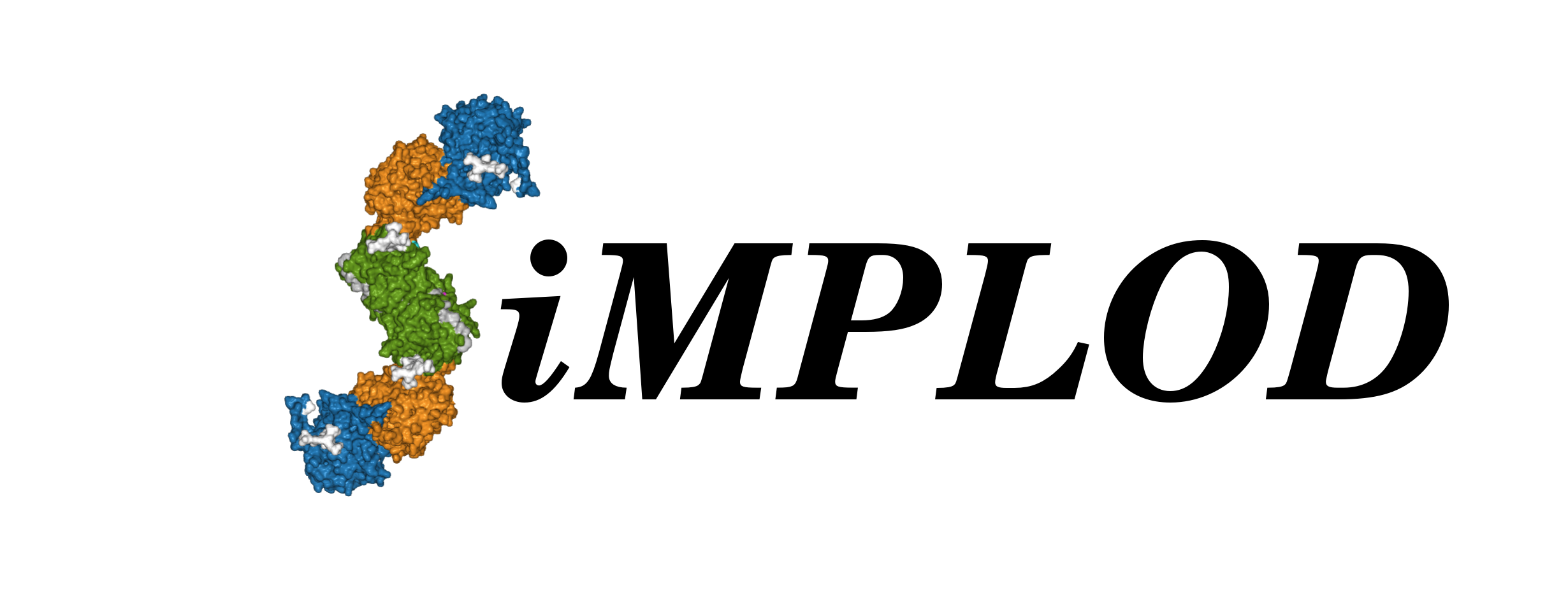 About
Contact
References
Structures
Adv. Search
Stats
Demo
About
Contact
References
Structures
Adv. Search
Stats
Demo
| LH1 delta586-634 | ||
| SiMPLOD ID |
SiMPLOD1-327 | |
| Isoenzyme |
Lysyl Hydroxylase 1 (human) - UniProt - Full Info | |
| Nucleotide mutation |
PLOD1 NM_000302.2:c.1756-?_1902+?del - NCBI RefSeq | |
| Mutation type |
Pathogenic | |
| LOVD |
c.1756-?_1902+?del | |
| Disease Phenotype |
Kyphoscoliotic Ehlers-Danlos Syndrome (Type VIa) Link1 Link2 | |
| Clinical Databases |
OMIM: 225400 Orphanet: ORPHA:1900 ICD-10: Q79.6 MeSH: C536198 | |
| Evidence at protein level |
This variant is EXTREMELY UNLIKELY to be compatible with a folded LH enzyme. The representation shown in the structure viewer is therefore for mere display purposes and does not refer to an actual predicted existing protein product. | References |
Pousi et al., 1998 - DOI - PubMed Hilderink et al., 1995 - PubMed Krieg et al., 1979 - PubMed Ihme et al., 1984 - DOI - PubMed |
Notes from publications |
This partial deletion in PLOD1 gene was reported by Pousi et al. in a patient with Ehlers-Danlos Syndrome Type VI (combined with a splicing defect in the other allele). The phenotype associated to this variant was also reported as Nevo Syndrome, now merged with Kyphoscholiotic Ehlers-Danlos (type VIa) syndrome. |
| Related Entries |
SiMPLOD1-328: LH1 ASN587ARG;GLY592ALA;PRO597ARGFS (Pathogenic) SiMPLOD2-1061: LH2a SER597SER (SNP) SiMPLOD1-47: LH1 ARG588LEU (Uncertain significance) SiMPLOD1-48: LH1 ARG588HIS (SNP) SiMPLOD1-870: LH1 ARG588CYS (SNP) SiMPLOD1-871: LH1 ARG588GLY (SNP) SiMPLOD2-229: LH2a ARG598HIS (Pathogenic) SiMPLOD2-992: LH2a ARG598CYS (SNP) SiMPLOD3-620: LH3 ARG599TRP (SNP) SiMPLOD3-690: LH3 ARG599ARG (SNP) SiMPLOD3-691: LH3 ARG599SER (SNP) SiMPLOD2-982: LH2a ILE599VAL (SNP) SiMPLOD1-807: LH1 GLY591ALA (SNP) SiMPLOD1-808: LH1 GLY591ASP (SNP) SiMPLOD2-241: LH2a GLY601VAL (Pathogenic) SiMPLOD6-240: LH2b GLY622CYS (Pathogenic) SiMPLOD1-328: LH1 ASN587ARG;GLY592ALA;PRO597ARGFS (Pathogenic) SiMPLOD1-778: LH1 TYR593TYR (SNP) SiMPLOD3-672: LH3 TYR604TYR (SNP) SiMPLOD1-100: LH1 GLU594LYS (Uncertain significance) SiMPLOD1-101: LH1 GLU594END (SNP) SiMPLOD1-741: LH1 ASN595ASN (SNP) SiMPLOD1-928: LH1 ASN595LYS (Uncertain significance) SiMPLOD3-458: LH3 ASN606ASN (SNP) SiMPLOD3-459: LH3 ASN606LYS (SNP) SiMPLOD1-223: LH1 VAL596VAL (Benign/Likely benign) SiMPLOD1-224: LH1 VAL596VAL (SNP) SiMPLOD1-896: LH1 VAL596MET (SNP) SiMPLOD6-334: LH2b VAL627ALA (Pathogenic) SiMPLOD1-169: LH1 PRO597LEU (Uncertain significance) SiMPLOD1-170: LH1 PRO597PRO (Likely benign) SiMPLOD1-171: LH1 PRO597PRO (SNP) SiMPLOD1-172: LH1 PRO597SER (Uncertain significance) SiMPLOD1-328: LH1 ASN587ARG;GLY592ALA;PRO597ARGFS (Pathogenic) SiMPLOD2-253: LH2a THR608ILE (Pathogenic) SiMPLOD1-337: LH1 ILE599FS (Pathogenic) SiMPLOD3-600: LH3 VAL610MET (SNP) SiMPLOD1-825: LH1 HIS602HIS (SNP) SiMPLOD1-826: LH1 HIS602GLN (SNP) SiMPLOD2-952: LH2a MET613VAL (SNP) SiMPLOD1-136: LH1 ILE606ILE (Likely benign) SiMPLOD1-137: LH1 ILE606ILE (Conflicting interpretations) SiMPLOD1-780: LH1 GLY607CYS (SNP) SiMPLOD1-781: LH1 GLY607SER (SNP) SiMPLOD3-469: LH3 GLY618GLY (SNP) SiMPLOD3-408: LH3 TYR619TYR (SNP) SiMPLOD3-610: LH3 GLU620LYS (SNP) SiMPLOD1-895: LH1 ARG610GLN (SNP) SiMPLOD1-1195: LH1 ARG610TRP (Uncertain significance) SiMPLOD2-1104: LH2a ASN620SER (SNP) SiMPLOD3-1165: LH3 GLN622END (SNP) SiMPLOD1-206: LH1 TRP612END (Uncertain significance) SiMPLOD1-207: LH1 TRP612CYS (Pathogenic) SiMPLOD1-122: LH1 HIS613SER (for biochemistry) SiMPLOD3-364: LH3 GLN625ARG (SNP) SiMPLOD2-1040: LH2a ILE626THR (SNP) SiMPLOD3-1147: LH3 LEU627PRO (Pathogenic) SiMPLOD2-1012: LH2a ARG627GLN (SNP) SiMPLOD2-1069: LH2a ARG627GLY (SNP) SiMPLOD2-1070: LH2a ARG627TRP (SNP) SiMPLOD3-650: LH3 ARG628GLN (SNP) SiMPLOD3-678: LH3 THR629THR (SNP) SiMPLOD3-706: LH3 THR629MET (SNP) SiMPLOD2-248: LH2a PHE629SER (Likely pathogenic) SiMPLOD3-316: LH3 TYR630END (Likely pathogenic) SiMPLOD3-462: LH3 TYR630CYS (SNP) SiMPLOD3-463: LH3 TYR630PHE (SNP) SiMPLOD3-464: LH3 TYR630SER (SNP) SiMPLOD1-329: LH1 PRO622ARGFS (Pathogenic) SiMPLOD1-739: LH1 ALA621VAL (SNP) SiMPLOD2-1085: LH2a ALA631VAL (SNP) SiMPLOD3-468: LH3 GLY632GLY (SNP) SiMPLOD1-173: LH1 PRO622LEU (Uncertain significance) SiMPLOD1-329: LH1 PRO622ARGFS (Pathogenic) SiMPLOD1-930: LH1 PRO622SER (Uncertain significance) SiMPLOD3-540: LH3 MET634VAL (SNP) SiMPLOD1-768: LH1 THR624ARG (SNP) SiMPLOD1-932: LH1 THR624MET (Uncertain significance) SiMPLOD3-604: LH3 THR635ILE (SNP) SiMPLOD2-995: LH2a LEU635LEU (SNP) SiMPLOD3-623: LH3 GLU636LYS (SNP) SiMPLOD1-877: LH1 LYS626LYS (SNP) SiMPLOD3-466: LH3 SER637ILE (SNP) SiMPLOD3-467: LH3 SER637THR (SNP) SiMPLOD3-700: LH3 LEU638LEU (SNP) SiMPLOD1-1156: LH1 TYR628END (SNP) SiMPLOD3-439: LH3 PRO640PRO (SNP) SiMPLOD1-756: LH1 GLY630SER (SNP) SiMPLOD2-242: LH2a GLY640ASP (Pathogenic) SiMPLOD1-933: LH1 TYR631CYS (Uncertain significance) SiMPLOD2-1109: LH2a TYR641CYS (SNP) SiMPLOD3-386: LH3 TYR642TYR (SNP) SiMPLOD2-987: LH2a THR643MET (SNP) SiMPLOD2-991: LH2a THR643THR (SNP) SiMPLOD1-49: LH1 ARG634ARG (Uncertain significance) | |
| Last Update |
2021-06-23 08:38:51 | |
|
The three-dimensional visualization is currently based on the homology model of full-length, dimeric human LH1 (generated using the crystal structure of full-length human LH3 as template). You may select a different PDB model file to visualize the mutation(s) using the drop-down menu below (page will refresh): |
||
Thank you for using SiMPLOD - Created by Fornerislab@UniPV Follow @Fornerislab - Last curated update: 1970-01-01 00:00:00
We truly hate messages and disclaimers about cookies and tracking of personal info. But don't worry, we don't use any.